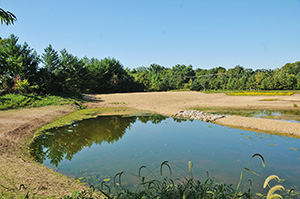2013 Community Stream Stewards
Stormwater Wetland Walk
with Bel Pachhai, PWC Watershed Management
presented on September 7 2013
Review by Kelly Moravec
Constructed Wetland at Pond 494
 In order to retrofit an existing stormwater facility into constructed wetlands, you need to locate ones where there is enough space to create the necessary depth of water. Last year, the county completed a study and selected Pond 494 by Mullen Elementary School as an ideal location for the first constructed wetlands project. In order to retrofit an existing stormwater facility into constructed wetlands, you need to locate ones where there is enough space to create the necessary depth of water. Last year, the county completed a study and selected Pond 494 by Mullen Elementary School as an ideal location for the first constructed wetlands project.
Pond 494 is in the Broad Run watershed, and before retrofitting into constructed wetlands, it was an extended dry detention pond – basically, a grassy area with a pipe. It is currently thought that this method only removes 15-30 percent of phosphorous. The constructed wetlands design for Pond 494 meets the requirement to remove 50-75 percent of phosphorous.
Field Trip to Pond 494
Seven people, mostly current or prior-year Virginia Master Naturalist program students, participated in the field trip to Pond 494 on September 7, 2013. Bel Pachhai, environmental engineer, watershed management branch, led the hour-long walk through the almost-completed constructed wetlands.
The area, about 3.8 acres in size, is in the Broad Run Watershed just north of Mullen Elementary School, off of Rodes Drive in Manassas. It was a lovely morning to take a walk, with three or four dragonfly species flitting about, crickets humming, a killdeer calling, a turkey vulture soaring, and tickseed sunflowers waving in the sun.
It was exciting to see this first-ever constructed wetland in Prince William County, and it was amazing that just a few months before, it was a grassy field. The work started in June and is not yet complete – plants still need to be installed, so there is still a lot of dirt (covered by hay), but the overall shape is in place. The low level drain was open and water was not ponding so survey work could be completed. However, some algae-filled small pools, created by continuous small flow from one of the inlets, were evident.
About 23 Canada geese landed as we surveyed the area, taking advantage of the low water. It is estimated that when the project is complete, there will not be a large geese problem because they prefer grassy areas.
It is difficult to find the right fit for this type of project – it depends on the available space, the right soil, geological issues such as the bedrock, and of course the funds available. Two other sites in the Broad Run watershed have been identified as possible retrofitting sites, but the bedrock at the surface presents issues. It can be expensive to change the soil and control the water with bedrock at the surface.
Pond 494’s area allows for easy access to maintain vegetation as well as remove sediments – the sediments will be collected in the large pool along Rodes Drive, and this will help reduce maintenance issues. A fence surrounds the perimeter of the area and will remain for safety purposes, as the area is surrounded by a housing development and elementary school.
The estimated cost of the project is $80,000, which was funded by Prince William County’s stormwater fee. Residential and nonresidential owners of developed property pay the Storm Water Management Fee on their bi-annual real estate bill: $37.10 /year for single family homes, $27.85/year for townhomes and $18.02/ 1,000 sq ft. for commercial development. |